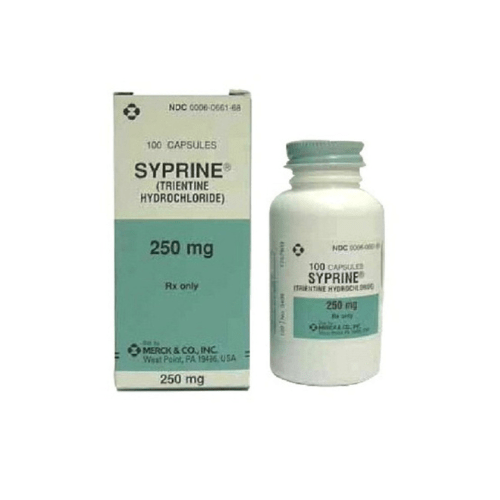
In the realm of rare genetic disorders, Wilson’s disease stands out as a condition that disrupts copper metabolism, leading to its excessive accumulation in the body. This accumulation can cause a range of debilitating symptoms, affecting various organs, including the liver, brain, and eyes. Thankfully, Syprine (trientine hydrochloride) emerges as a therapeutic lifeline, offering a safe and effective treatment option for individuals battling Wilson’s disease.
FDA Approval:
November 8, 1985, the FDA granted Syprine its approval, recognizing its efficacy in managing Wilson’s disease. This landmark decision paved the way for Syprine to become a cornerstone of treatment for this complex disorder.
Manufacturing Details:
Bausch Health Companies Inc., a renowned pharmaceutical entity, rigorously oversees the production of Syprine. The meticulous manufacturing process, adhering to stringent quality control measures, is conducted to ensure consistency and efficacy. The drug’s chemical synthesis is intricately managed, aligning with the commitment to maintaining high standards in its production.
Indication and Usage:
Syprine is prescribed for Wilson’s disease patients who cannot tolerate Penicillamine. It is recommended when continued Penicillamine treatment becomes impossible due to intolerable or life-threatening side effects. Syprine is not intended for the treatment of biliary cirrhosis.
Mechanism Of Syprine:
Syprine works by chelating copper, effectively removing excess copper from the body and restoring balance to copper metabolism. This action helps alleviate the detrimental effects of copper accumulation and improve the overall health of individuals with Wilson’s disease.
What Is Wilson’s Disease?
Wilson’s disease is a rare genetic disorder that causes the accumulation of copper in various organs of the body, primarily the liver and brain. This condition is inherited in an autosomal recessive manner, meaning that an individual must inherit a mutated gene from both parents to develop the disease.
Liver damage:
- Jaundice (yellowing of the skin and eyes)
- Fatigue
- Abdominal pain
- Nausea and vomiting
- Loss of appetite
- Weight loss
- Swollen belly (ascites)
- Dark urine
- Light-colored stools
Neurological problems:
- Tremors
- Clumsiness
- Dysarthria (slurred speech)
- Difficulty swallowing
- Slow or repeated movements
- Weak muscles
- Trouble swallowing
- Slurred speech
- Poor coordination
- Drooling
- Decreased fine motor abilities
Eye problems:
- Kayser-Fleischer rings (brown rings around the cornea)
- Sunflower cataracts
- Photophobia (sensitivity to light)
Other symptoms:
- Fatigue
- Weakness
- Bone problems
- Mood swings
- Depression
- Anxiety
The symptoms of Wilson’s disease can vary depending on the severity of the disease and the age of onset. In some cases, there may be no symptoms at all. However, as the disease progresses, symptoms will typically develop.
Dosage Administration:
Syprine is available in 250 mg capsules, and the dosage is individualized based on the patient’s age, weight, and clinical response. Typically, adults and adolescents start with a dosage of 1000 mg per day, divided into four equal doses. The dosage may be adjusted as needed to maintain optimal copper levels.
It is crucial to administer Syprine 250 mg capsule on an empty stomach, either at least one hour before meals or two hours after meals. Additionally, it should be taken at least one hour apart from any other medication, food, or milk. The capsules must be swallowed whole with water and should not be opened or chewed. Following these specific instructions ensures optimal absorption and effectiveness of the medication.
Usage In Specific Populations
- Pregnancy: The use of medications during pregnancy requires careful consideration of potential risks and benefits. There may be limited data on the use of Syprine in pregnant women, and it is essential to consult with a healthcare provider to assess the potential risks to the fetus.
- Lactation: It is common for medications to pass into breast milk. If a woman is breastfeeding while taking Syprine, it is important to discuss the potential risks with a healthcare provider. The decision to continue or discontinue breastfeeding and the use of Syprine should be made in consultation with a healthcare professional.
- Pediatric Use: The use of Syprine in pediatric populations is determined based on factors such as the severity of the condition and potential benefits versus risks. Dosage and safety considerations may vary for children, and pediatric patients should be monitored closely by healthcare professionals.
- Geriatric Use: Geriatric populations may have different considerations regarding medication use. Factors such as renal function, coexisting conditions, and potential interactions with other medications may need to be taken into account when prescribing Syprine to older individuals.
Warnings and Precautions:
- While Syprine offers significant benefits for Wilson’s disease patients, it is crucial to exercise caution during its administration.
- Potential side effects include iron deficiency anemia, systemic lupus erythematosus, dystonia, muscular spasm, and myasthenia gravis.
- Regular monitoring of copper levels and blood cell counts is essential during Syprine treatment. Patients, especially women, should be closely monitored for the evidence of iron deficiency anemia.
- Mineral supplements should not be given because they may block the absorption of Syprine.
Contraindications:
Syprine is contraindicated in patients with a known hypersensitivity to trientine hydrochloride or any of the excipients in the drug. Additionally, Syprine is not recommended for the treatment of cystinuria or rheumatoid arthritis.
Side Effects:
The most common side effects associated with Syprine include iron deficiency anemia, systemic lupus erythematosus, dystonia, muscular spasm, and myasthenia gravis. While these side effects are often manageable, patients should be informed of their potential occurrence.
Storage Condition
Store between 2-8°C (36-46°F). Ensure the container is tightly closed. Keep the medicine away from pet and children.
Recent Advances:
Ongoing research explores Syprine’s potential beyond Wilson’s disease. Promising findings indicate efficacy in copper-associated liver disorders and neurological conditions, expanding its therapeutic possibilities and offering hope to patients.
How To Buy Syprine
Syprine procurement is made easy online. Exclusive to the US and Europe, contact SANSFRO or similar import specialists. For Trientine 250 mg capsule price details, based on factors and specifications, reach our Patient Support Team at (91) 93157 05373 or help@sansfro.com. Stay updated on Indian market pricing through our dedicated team.
Conclusion:
Syprine, FDA-approved for Wilson’s disease, symbolizes hope with its proven efficacy and rigorous manufacturing. Despite precautions, its benefits surpass risks. Ongoing research enhances its therapeutic role, making it a crucial treatment cornerstone, providing a lifeline for those with Wilson’s disease.
Reference:



